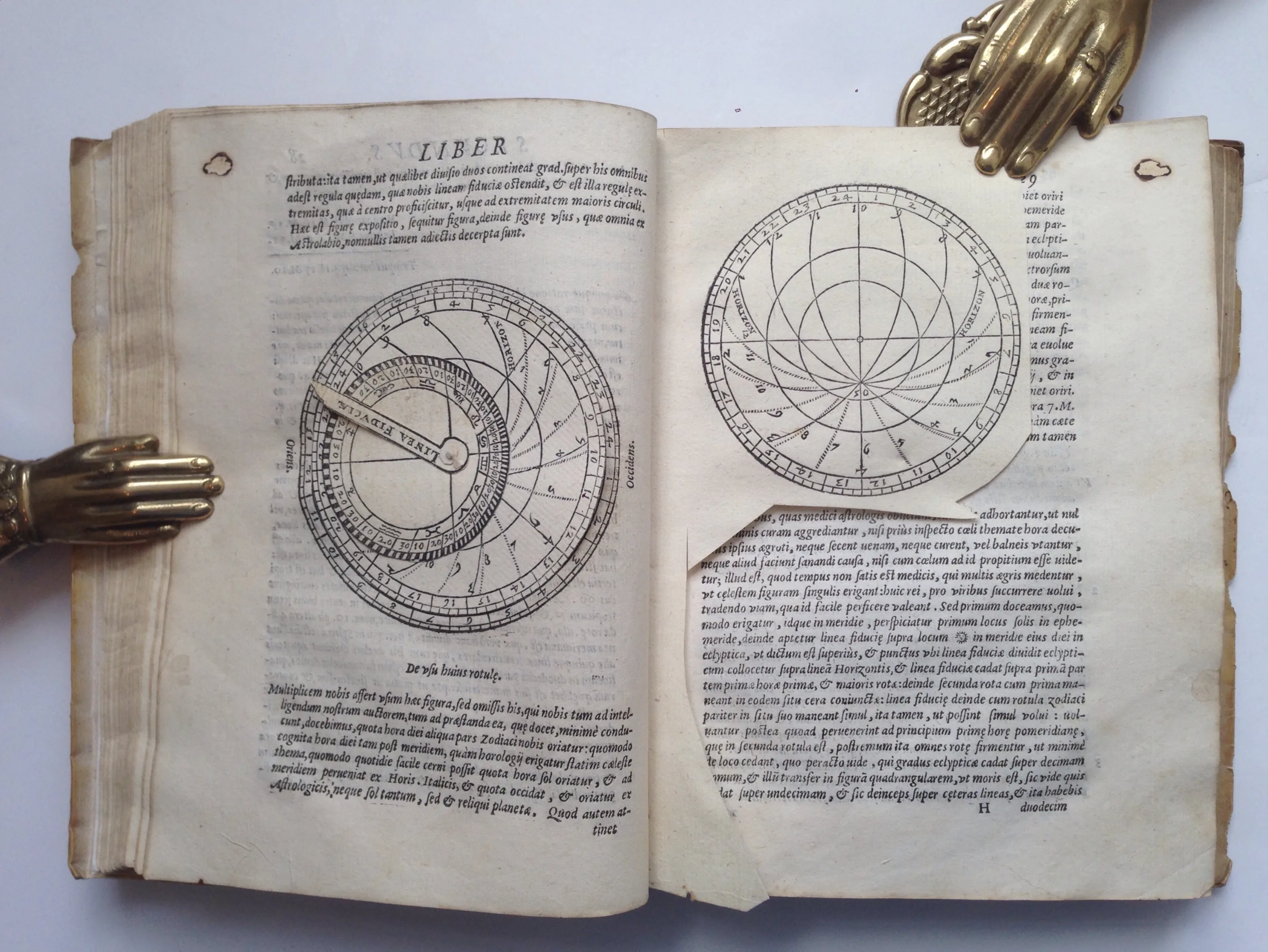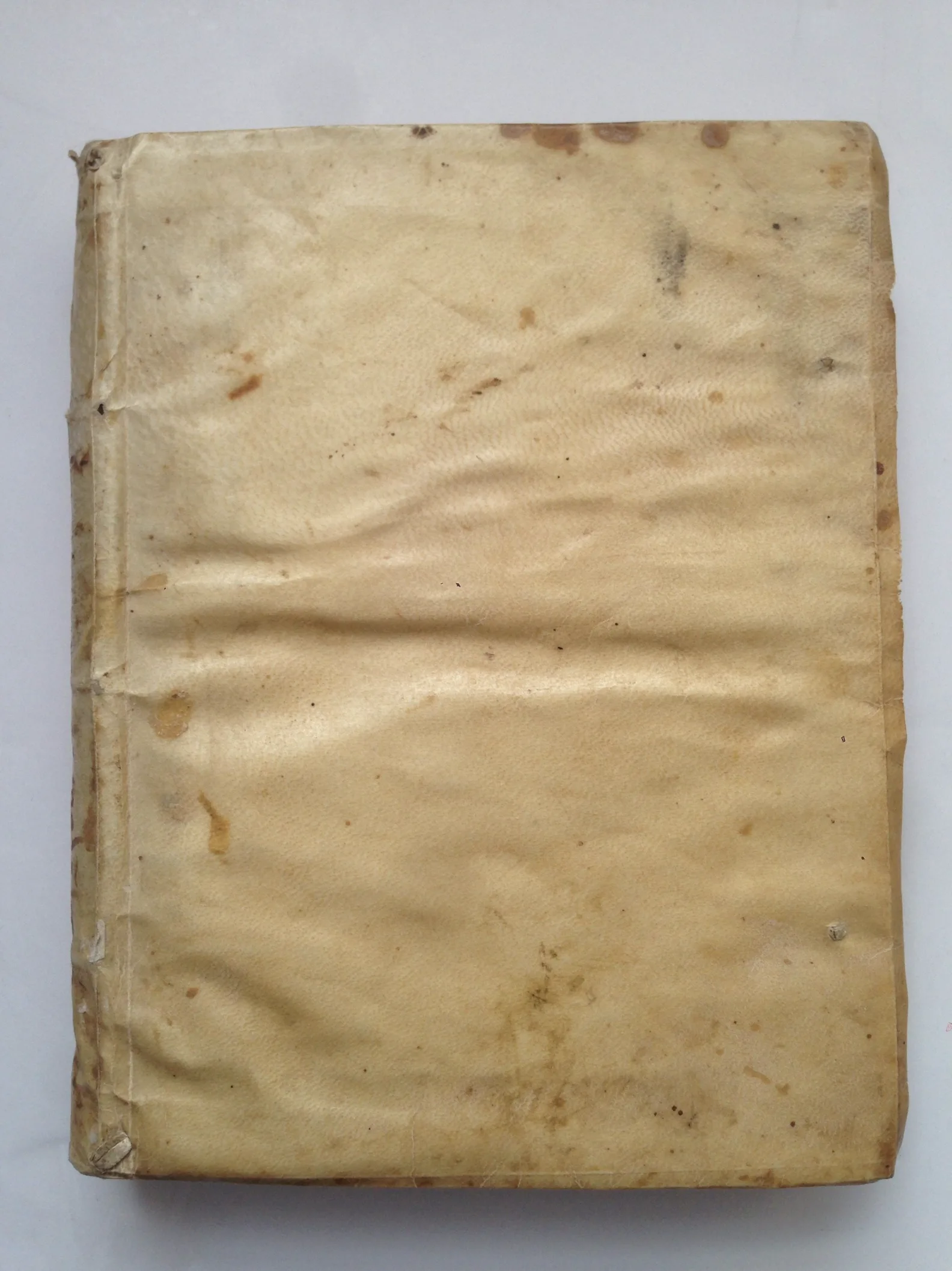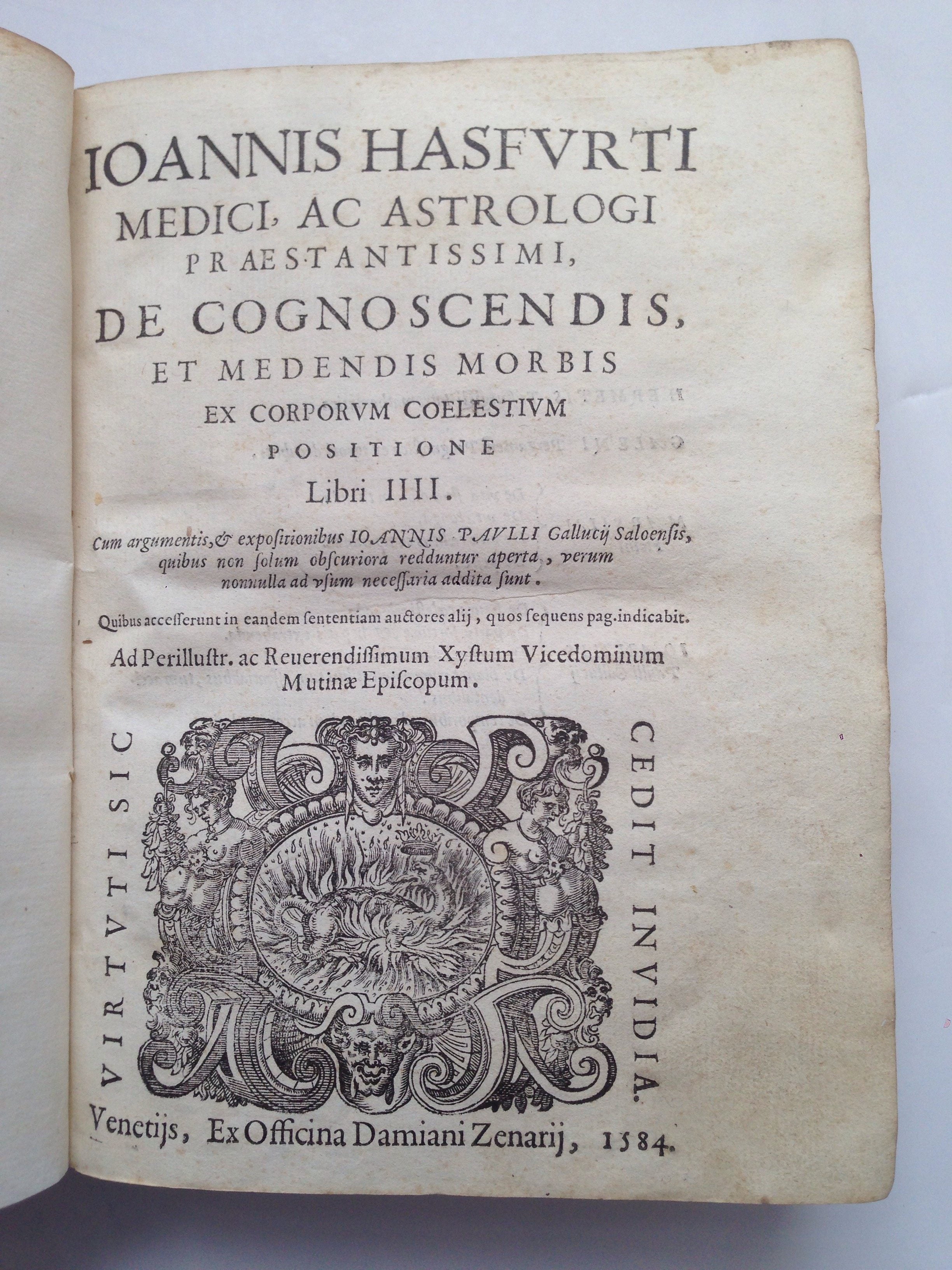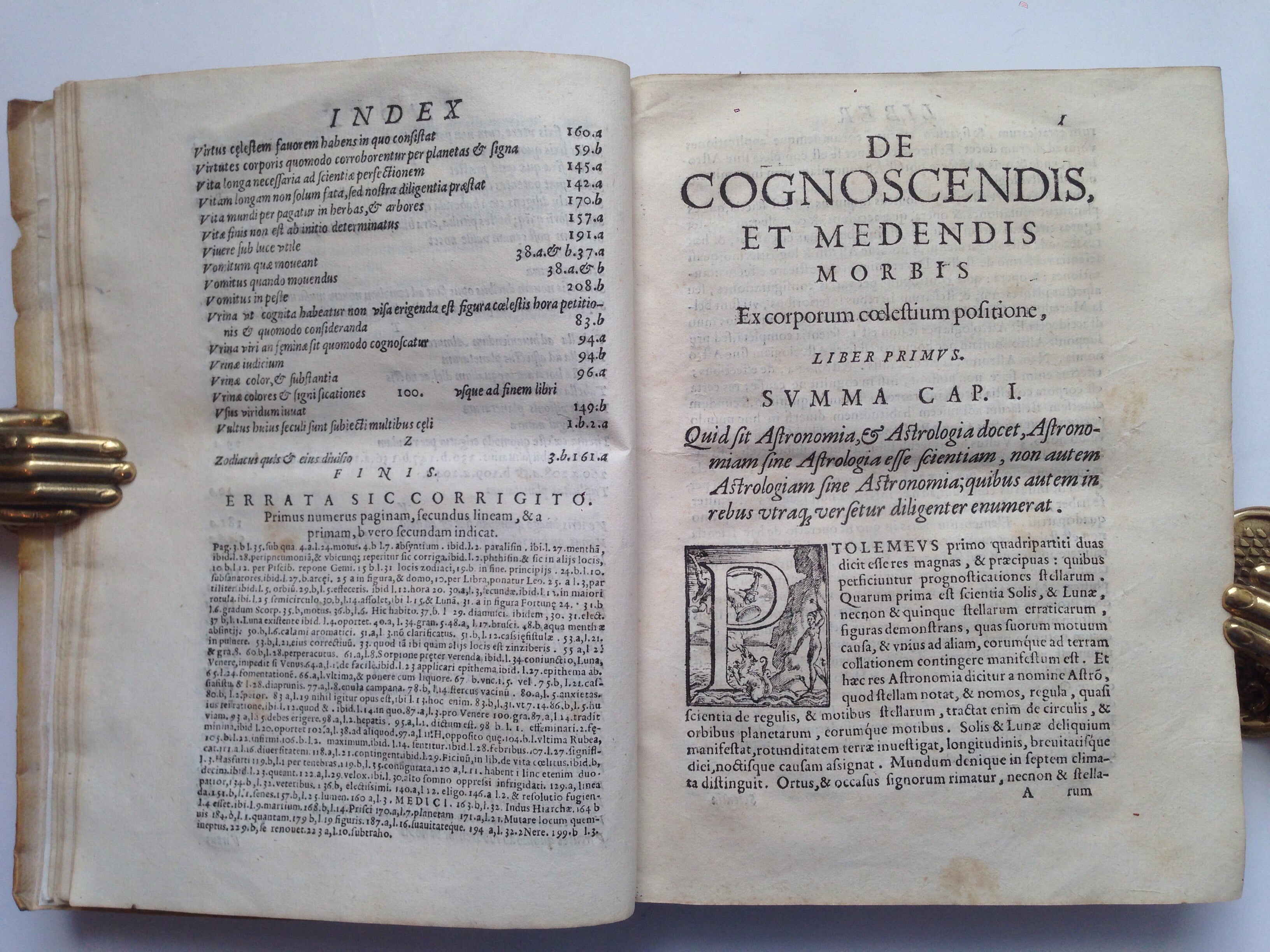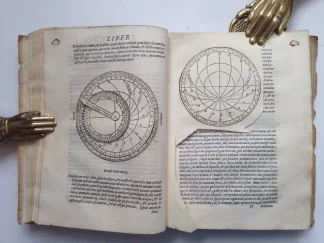VIRDUNG VON HASSFURT, Johannes.
De cognoscendis, et medendis morbis ex corporum coelestium positione Libri IIII …… Cum argumentis et expositionibus Ioannis Paulli Gallucii Saloensis
Venice, Damiano Zenaro, 1584£4,950.00
FIRST and ONLY EDITION thus. 4to, ff. (12), 228. Roman and Italic letter. Large printer’s woodcut device on title-page, foliated and historiated initials, decorative head- and tail- pieces; several horoscope charts and half page astrological diagrams; 7 volvelles, 1 between G4 and H1, 3 mounted on verso of G4 and 3 loose. Very light browning in places, the odd spot, small marginal burn hole to ll. 28-29. A very good, crisp, well-margined copy in contemporary limp vellum, yapp edges, remains of ties; re-cased. Contemporary Latin annotations in a few places, “Hasfurt” inked by early hand on upper edge.
An important collection of works on astrological medicine united in this edition for the first time by the Italian scholar Giovanni Paolo Gallucci (1538-1621), including: the treatise in 4 books by Johann Virdung (ca.1465-ca.1535), published in 1532; the “Iatromathematica” attributed to Hermes Trismegistus; the “Prognostica” by Imbrasius of Ephesus (pseudo Galen); and “De triplici vita” in 3 books (“De vita sana”, “De vita longa”, “De vita coelitus comparanda”), with an early treatise on the plague (“Epidemiarum antidotus”), both by the Florentine philosopher Marsilio Ficino (1422-1499), and the “Introductio ad astrologiam” by Gallucci himself.
Gallucci was a translator and cartographer. After completing his education in Padua, he moved to Venice. His interests ranged from astronomy to medicine and literature. He was one of the founders of the second Venetian Academy and wrote several works on astronomy, such as the important star atlas “Theatrum mundi, et temporis” (1588). Virdung was an influential physician and astrologer from Hasfurt. He studied in Leipzig and Krakow where he attended the lectures of Albertus de Brudzewo and Johannes von Glogau. In 1492 Virdung moved to Heidelberg where taught medicine, mathematics and astronomy and entered the service of the Electoral Palatine court, producing yearly prognostications regarding the ruling planets, the interpretation of eclipses and natural disasters, as well as social events (Joachimite prophecies). Virdung’s bibliography includes at least 80 astrological works in German and Latin.
After a dedicatory letter by Gallucci to the Bishop of Mantua, Sisto Vicedomini, explaining the relationship between disease and the influence of the stars over human bodies, the volume opens with Virdung’s 4 books, each introduced by a short summary. Book 1 focuses on the basics of astrology (zodiac, stars, planets and other celestial bodies, such as the Moon), according to principles by Galen, Ptolemy (Opus Quadripartitum) and Cardan. Book 2 and 3 concern the classification of diseases and their remedies (drugs’ ingredients; laxative and phlebotomy; bandages, embrocation and balms to relieve pain; poultice for the head and the stomach, infusions). They particularly deal with the definition of vomit and faeces as movements of the body to expel poison and humours, as well as with the issue of the periods of major danger for the health, for instance the moon phases. Book 4 discusses symptoms and features of the body which reveal specific diseases depending on the position of the stars, such as face appearance and the colour of urine. There follows the “Iatromathematica”, supposedly by the Egyptian philosopher Hermes Trismegistus, a treatise in Latin translation which refers to medical astrology as a discipline subordinating clinical observation and therapeutic praxis to the scrutiny of the stars; the “Prognostica” or “De decubitu” in 13 chapters, an anonymous work on prognosis bringing together materials from the Galenic “Crises”, as well as from the iatromathematical tradition. The second part of the volume contains Ficino’s “De triplice vita”, preceded by Gallucci’s address to the reader. One of Ficino’s later works, inspired by Galen, Plato and the Arab “Picatrix”, and divided into three parts: “De vita sana”, dedicated to Lorenzo the Magnificent, aiming at helping scholars achieve a healthy life through suitable diet and habits; “De vita longa”, dedicated to the noble Florentine Filippo Valori, on eternal happiness, providing similar advice to the elderly; “De vita coelitus comparanda”, prescribing gold and gems (talismans) as powerful health remedies. Last, a short astrological treatise by Gallucci dealing with celestial phenomena and related calculations, zodiac and planets, connection between stars and Fortune, and their influences on the bodies.
BM STC, It., 729; Cantamessa, II, 4745 (“Opera di significativa importanza, edita con grande cura e scritta con ogni possibile chiarezza”); Houzeau-Lancaster, I, 5860. Dürling, 4631; Wellcome, I, 3077. Not in Adams. Not in Brunet or Graesse.In stock


